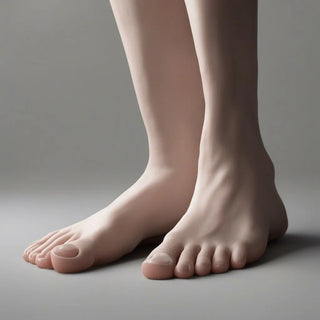Diabetic foot ulcers are a common complication of diabetes that can lead to infection, amputation, and disability if left untreated. Taking preventative care of your feet is essential if you have diabetes. This article covers the causes of diabetic foot ulcers and steps you can take to avoid them.
What Causes Diabetic Foot Ulcers?
- Neuropathy - Nerve damage from high blood sugar reduces sensation in the feet, so injuries or irritation goes unnoticed.
- Poor circulation - Impaired blood flow slows healing and delivery of nutrients and oxygen to tissue.
- High blood sugar - Prolonged hyperglycemia impairs white blood cells that fight infection.
- Foot deformities - Bunions, hammertoes, and bone changes put added pressure on sites prone to ulcers.
Warning Signs
Watch for:
- Numbness, tingling, or pain in the feet
- Reddened areas, blisters, calluses
- Cracked dry skin, peeling
- Abnormal warmth or coldness
Seek immediate care for any opening or break in the skin to prevent an ulcer from forming.
Preventing Foot Ulcers
Daily foot care and routine check-ups are key, including:
- Washing & fully drying feet daily, moisturizing skin
- Inspecting feet for any red spots, cuts, irritation
- Wearing properly fitted shoes with cotton socks, avoid going barefoot
- Keeping toenails clipped straight across
- Getting regular podiatrist care for callus removal, trimming issues
- Checking water temperature before bathing
- Stopping smoking to improve circulation
Blood sugar control is also imperative. Work closely with your healthcare provider to keep A1c levels optimal.
Statistics on Diabetic Foot Ulcers
- 15-25% of people with diabetes will develop a foot ulcer in their lifetime
- Over 2 million diabetic foot ulcers occur each year in the US
- Of those with a diabetic foot ulcer, 20% will undergo an amputation
- 5 year mortality rate after amputation can be up to 70%
Seeking Early Treatment
See a podiatrist or wound care provider at the first sign of an ulcer. Left untreated, ulcers can enlarge, get infected and penetrate to deeper tissues and bone. Advanced ulcer treatments are available to promote healing.
Protect your feet and avoid devastating complications with diligent preventive care. Checking feet daily and promptly treating any ulcers improves outcomes for those with diabetes. Discuss with your healthcare provider your eligibility for diabetic shoes and custom inserts.
Disclaimer: This article provides general information only and is not medical advice. Consult a doctor for appropriate diabetic and foot care.
References
Frykberg, R. G., & Banks, J. (2015). Challenges in the treatment of chronic wounds. Advances in Wound Care, 4(9), 560–582.
https://doi.org/10.1089/wound.2015.0635
Hingorani, A., LaMuraglia, G. M., Henke, P., Meissner, M. H., Loretz, L., Zinszer, K. M., Driver, V. R., Frykberg, R., Carman, T. L., Marston, W., Mills, J. L., & Murad, M. H. (2016). The management of diabetic foot: A clinical practice guideline by the Society for Vascular Surgery in collaboration with the American Podiatric Medical Association and the Society for Vascular Medicine. Journal of Vascular Surgery, 63(2), 3S-21S.
https://doi.org/10.1016/j.jvs.2015.10.003
Jeon, Y. H. (2018). Diabetes mellitus and skin diseases. Korean Journal of Medicine, 93(6), 495–501.
https://doi.org/10.3904/kjm.2018.93.6.495
Stay tuned for more insightful content on the role of nutrition in health and healing from Condition Directed Supplements.
